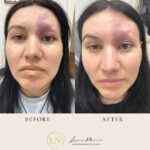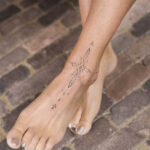How Bad Do Finger Tattoos Hurt? Finger tattoos, a popular form of body art, can range from mildly uncomfortable to quite painful. At tattooat.com, we delve into the specifics of finger tattoo pain, offering insights into pain management, design choices, and aftercare practices. This comprehensive guide will explore the factors that influence pain levels, helping you make informed decisions about your next finger ink and ensuring a smoother tattooing journey.
1. Understanding the Finger Tattoo Pain Factor
Is getting a finger tattoo a painful experience? Yes, getting a finger tattoo can be quite painful, often ranking high on the tattoo pain scale. The intensity varies based on several factors, notably the thin skin, proximity to bone, and numerous nerve endings in the fingers. Let’s explore these factors to understand what influences the pain:
- Bone Proximity: Fingers have very little fat and muscle, meaning the skin lies almost directly on the bone. This makes the tattooing process more intense as the vibrations from the tattoo machine can be felt more acutely.
- Nerve Endings: Fingers are packed with nerve endings, which make them highly sensitive to pain. The needle’s repeated action can trigger a strong pain response.
- Skin Thinness: The skin on the fingers is thinner compared to other body parts. This thinness makes the area more susceptible to pain and irritation during tattooing.
- Ink Fading: Finger tattoos are prone to fading, which may require touch-ups. Each touch-up session will involve the same level of pain, potentially making the overall experience more prolonged and uncomfortable.
Due to these factors, pain management becomes crucial. Options like tattoo numbing creams can significantly reduce discomfort. Additionally, choosing simpler designs that require less time and detail can also help minimize pain.
2. Finger Tattoo Pain Scale: What to Expect
What number do finger tattoos rank on the tattoo pain scale? Finger tattoos typically rank high on the tattoo pain scale, often scoring between 7 and 9 out of 10. This is due to the unique anatomy of the fingers, which include thin skin, proximity to bone, and a high concentration of nerve endings.
To give you a clearer idea, here’s a comparative look at how finger tattoos stack up against other common tattoo locations:
| Tattoo Location | Pain Level (1-10) | Pain Factors |
|---|---|---|
| Fingers | 7-9 | Thin skin, close to bone, numerous nerve endings |
| Rib Cage | 9 | Thin skin, close to bone, little fat or muscle |
| Forearm | 2-3 | More flesh, fewer nerve endings |
| Outer Thigh | 4-5 | Muscles and fat provide cushioning |
| Upper Back | 5 | Thicker skin, fewer nerve endings |
| Inner Bicep | 6 | Thinner skin, more nerve endings |
| Wrist | 6 | Varies depending on location (inner vs. outer), thin skin |
| Elbow | 7-8 | Bony area, nerves pass through |
| Knee | 9 | Sciatica nerve, thin skin |
| Groin/Armpit | 9-10 | Delicate skin, high volume of nerve endings, close to lymph nodes |
| Collarbone/Shoulder | 9-10 | Right over the bone, little to no fat, pain radiates through the neck |
This comparison shows that finger tattoos are generally more painful than areas like the forearm or thigh but may be slightly less intense than rib cage or groin tattoos. Understanding this ranking can help you mentally prepare and consider pain management options.
3. Pain Variations: Knuckles vs. Sides of Fingers
Do knuckle tattoos hurt more than side-of-finger tattoos? Yes, knuckle tattoos generally hurt more than side-of-finger tattoos due to the direct contact with bone and the skin’s tension over the knuckles. The pain experienced during finger tattoos can differ significantly based on the specific location on the finger. Here’s a detailed comparison:
- Knuckles: These areas have very thin skin stretched tightly over bone, with minimal fat or muscle for cushioning. As a result, the vibrations and pressure from the tattoo needle are felt more intensely, making it a high-pain area.
- Sides of Fingers: The sides of the fingers tend to have slightly more flesh and fewer nerve endings compared to the knuckles. This can result in a less intense pain experience, although it still ranks relatively high on the pain scale.
- Inner Finger: This area is particularly sensitive due to the high concentration of nerve endings. Tattoos here can be quite painful, similar to the knuckles.
- Webbing Between Fingers: The skin here is very delicate, and the area is full of nerve endings. Tattoos in this location can be surprisingly painful.
Understanding these variations can help you make informed decisions about the placement of your finger tattoo. If you’re concerned about pain, opting for the sides of the fingers might be a better choice. Always consult with your tattoo artist for their professional opinion and advice on pain management.
4. Gender Differences in Finger Tattoo Pain
Are finger tattoos more painful for men or women? There is no definitive scientific evidence to suggest that finger tattoos are inherently more painful for one gender over the other. Pain perception is highly subjective and influenced by a variety of factors unique to each individual.
Here are some key elements influencing pain perception:
- Pain Tolerance: Pain tolerance varies significantly among individuals regardless of gender. Factors such as genetics, previous pain experiences, and psychological state can all influence how someone perceives pain.
- Skin Sensitivity: Differences in skin sensitivity can play a role. Some people naturally have more sensitive skin, which can amplify the pain experienced during a tattoo session.
- Hormonal Factors: Hormonal fluctuations, particularly in women, can affect pain sensitivity. For example, some women may find they are more sensitive to pain during certain phases of their menstrual cycle.
- Muscle and Fat Distribution: While fingers have minimal muscle or fat, slight variations can occur. These minor differences might influence the intensity of pain experienced.
Instead of focusing on gender, it’s more practical to consider individual pain tolerance and sensitivity. Preparation strategies, such as using numbing creams and staying relaxed, can help manage pain effectively, making the tattooing experience more comfortable for everyone.
5. The Tattooing Process: What Makes Finger Tattoos Unique
Why does the tattooing process on fingers intensify the pain? The tattooing process on fingers intensifies the pain due to the unique structural characteristics of the area, including thin skin, close proximity to bone, and a high concentration of nerve endings. Additionally, other factors related to the tattooing technique can also contribute to the level of pain experienced.
Let’s examine each element:
- Needle Pressure: Tattoo artists must use precise needle pressure to ensure the ink is properly embedded in the skin. On fingers, because there is less flesh, even slight variations in pressure can cause increased discomfort.
- Vibrations: The vibrations from the tattoo machine can be particularly jarring on the fingers. With minimal muscle or fat to absorb the vibrations, they are felt more acutely against the bone.
- Time and Complexity: The duration and complexity of the tattoo design can also impact pain levels. Longer sessions and intricate designs require more needle work, which can lead to increased pain and irritation.
- Ink Type and Quality: The type and quality of ink used can also play a role. Some inks may cause more irritation than others, which can intensify the pain. High-quality inks are generally smoother and cause less trauma to the skin.
- Artist’s Skill: The skill and experience of the tattoo artist are crucial. A skilled artist will know how to work efficiently and minimize trauma to the skin, which can reduce the overall pain.
To mitigate the pain during the tattooing process, consider using a topical numbing cream like Zensa Numbing Cream, which contains 5% lidocaine for maximum-strength pain prevention. It’s also important to communicate openly with your tattoo artist about your pain levels and take breaks if needed.
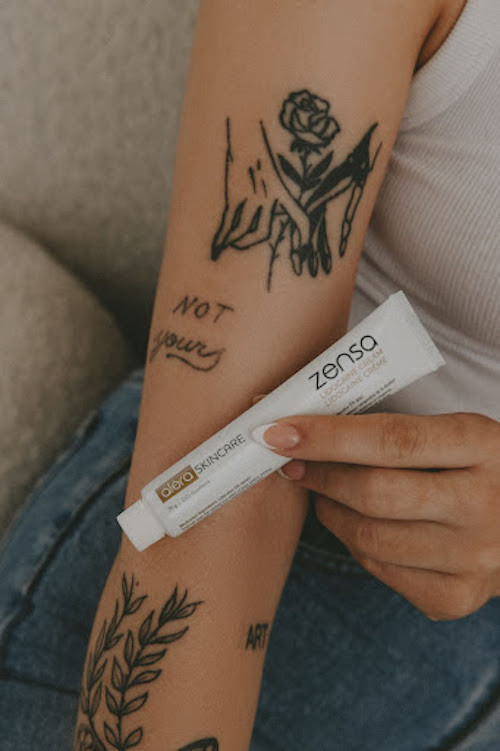 Painful Tattoo Placements
Painful Tattoo Placements
6. Managing Finger Tattoo Pain: Pre, During, and Post-Care
How can I effectively manage the pain associated with finger tattoos? Managing finger tattoo pain involves strategies that you can implement before, during, and after the tattooing process. These methods help minimize discomfort and promote proper healing.
Here are some key strategies:
Pre-Tattoo:
- Choose an Experienced Artist: Select a tattoo artist who has experience with finger tattoos. An experienced artist will know how to work efficiently and minimize trauma to the skin.
- Consultation: Discuss your pain concerns and management options with your artist. They can provide valuable advice and customize the process to your needs.
- Numbing Cream: Apply a high-quality tattoo numbing cream, such as Zensa Numbing Cream, about 30-45 minutes before your appointment. This cream contains 5% lidocaine to maximize pain prevention without affecting pigment retention.
- Avoid Blood Thinners: Refrain from taking blood-thinning medications like aspirin or ibuprofen before your tattoo session, as these can increase bleeding and discomfort.
- Stay Hydrated: Drink plenty of water in the days leading up to your appointment to keep your skin hydrated and more receptive to the ink.
- Eat a Meal: Have a nutritious meal before your appointment to stabilize your blood sugar levels and prevent lightheadedness.
During Tattoo:
- Communicate: Maintain open communication with your tattoo artist. Let them know if you are experiencing too much pain and need a break.
- Relaxation Techniques: Practice relaxation techniques, such as deep breathing, to help manage your anxiety and pain levels.
- Distraction: Bring a distraction, such as music or a book, to take your mind off the pain.
Post-Tattoo:
- Aftercare: Follow your tattoo artist’s aftercare instructions carefully. Proper aftercare is crucial for healing and preventing infection.
- Cleanliness: Keep the tattooed area clean by washing it gently with mild, fragrance-free soap and water.
- Moisturize: Apply a recommended tattoo aftercare lotion or balm to keep the skin moisturized and promote healing.
- Avoid Irritants: Avoid exposing the tattoo to harsh chemicals, direct sunlight, and tight clothing, all of which can irritate the skin and delay healing.
- Stay Hydrated: Continue to drink plenty of water to keep your skin hydrated from the inside out.
- Healthy Diet: Eat a balanced diet rich in vitamins and minerals to support your body’s healing process.
By following these strategies, you can effectively manage the pain associated with finger tattoos and ensure a smoother, more comfortable tattooing experience.
7. Numbing Creams: A Detailed Look at Pain Relief
Are tattoo numbing creams effective for finger tattoos? Yes, tattoo numbing creams are effective for finger tattoos as they contain ingredients like lidocaine that block pain signals. Using a numbing cream can significantly reduce the discomfort associated with finger tattoos, making the process more manageable. Here’s a detailed look at how these creams work and what to consider:
- How Numbing Creams Work: Numbing creams contain active ingredients such as lidocaine, prilocaine, or tetracaine, which are local anesthetics. These substances temporarily block nerve signals in the applied area, reducing the sensation of pain.
- Application Timing: For optimal effectiveness, apply the numbing cream 30-45 minutes before your tattoo session. This allows enough time for the cream to penetrate the skin and take effect.
- Application Technique: Apply a thick layer of the numbing cream to the area where you will be tattooed. Cover it with a plastic wrap (like saran wrap) to increase absorption by 300-500%. Remove the wrapping and gently dab away any excess cream right before the tattooing begins.
- Duration of Effect: The numbing effect typically lasts for 2-3 hours, depending on the product and individual factors. For longer sessions, you may need to reapply the cream, but always consult with your tattoo artist before doing so.
- Safety Considerations: Choose a reputable brand of numbing cream to ensure safety and effectiveness. Check the ingredients to ensure you are not allergic to any components.
- Artist Approval: Always consult with your tattoo artist before using a numbing cream. Some artists may have preferences or concerns about how the cream affects the skin and ink.
Zensa Numbing Cream is a popular choice among tattoo artists and clients alike. It contains 5% lidocaine for maximum-strength pain prevention without compromising pigment retention. Its unique formula does not contain vasoconstrictors, so it won’t temporarily change your skin’s texture or negatively affect ink settling, making it a reliable option for finger tattoos.
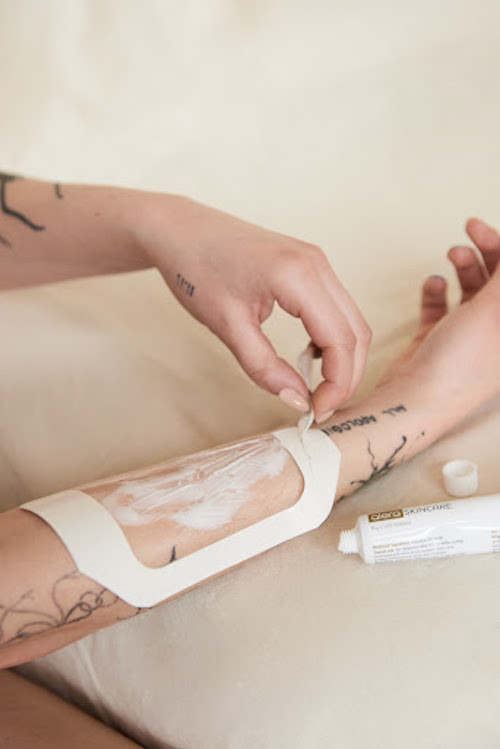 Tattoo Numbing Cream
Tattoo Numbing Cream
8. Finger Tattoo Aftercare: Ensuring Proper Healing
What aftercare steps are crucial for healing finger tattoos? Proper aftercare is crucial for healing finger tattoos to prevent infection, minimize fading, and ensure the longevity of your ink. Due to the frequent use of hands and exposure to various elements, finger tattoos require diligent care. Here’s a detailed guide to finger tattoo aftercare:
Immediate Aftercare (First Few Days):
- Keep it Clean: Gently wash the tattooed area with mild, fragrance-free soap and lukewarm water 2-3 times a day. Pat it dry with a clean paper towel.
- Moisturize: Apply a thin layer of a recommended tattoo aftercare lotion or balm after washing. Avoid using heavy, greasy products that can clog pores.
- Avoid Soaking: Refrain from soaking your tattooed finger in water for extended periods. This includes baths, swimming, and prolonged hand washing.
- Protect: Protect the tattoo from direct sunlight and harsh chemicals. Wear gloves when doing dishes or using cleaning products.
Ongoing Care (Weeks Following):
- Stay Hydrated: Drink plenty of water to keep your skin hydrated from the inside out.
- Avoid Irritants: Avoid using harsh soaps, sanitizers, or lotions on the tattooed area.
- Sun Protection: Always apply sunscreen to your tattoo when exposed to sunlight to prevent fading.
- Moisturize Regularly: Continue to moisturize the tattoo 2-3 times a day to keep the skin supple and prevent cracking.
- Avoid Friction: Minimize friction and rubbing against the tattoo. Wear gloves or protective coverings when necessary.
Long-Term Care:
- Touch-Ups: Be prepared for potential touch-ups. Finger tattoos are prone to fading due to frequent use and exposure.
- Professional Advice: Consult with your tattoo artist for any concerns or issues that arise during the healing process.
- Healthy Lifestyle: Maintain a healthy lifestyle with a balanced diet and regular exercise to promote overall skin health.
By following these aftercare steps, you can help ensure your finger tattoo heals properly and remains vibrant for years to come.
9. Factors Affecting Pain Tolerance: Beyond the Body
What other factors beyond physical ones affect pain tolerance during finger tattoos? Several psychological, emotional, and lifestyle factors significantly influence pain tolerance during finger tattoo sessions. A holistic approach that considers these elements can greatly enhance your experience.
Let’s explore these factors in detail:
- Psychological State: Your mental state plays a crucial role in how you perceive pain. Anxiety, fear, and stress can amplify pain sensations. Practicing relaxation techniques, such as deep breathing or meditation, can help calm your nerves and reduce pain.
- Emotional Well-being: Emotional well-being is closely linked to pain perception. Individuals experiencing depression, chronic stress, or other emotional difficulties may have a lower pain threshold. Engaging in activities that boost your mood, such as spending time with loved ones or pursuing hobbies, can improve your overall pain tolerance.
- Sleep Quality: Lack of sleep can increase sensitivity to pain. Aim for 7-8 hours of quality sleep in the nights leading up to your tattoo appointment. Adequate rest helps your body cope with stress and discomfort more effectively.
- Hydration: Dehydration can make your skin more sensitive and less elastic, potentially increasing pain during tattooing. Drink plenty of water in the days before your appointment to keep your skin hydrated and resilient.
- Nutrition: A balanced diet supports overall health and can influence pain tolerance. Consume a nutritious meal before your tattoo session to stabilize your blood sugar levels and provide your body with the energy it needs to cope with the process.
- Past Experiences: Previous experiences with pain can shape your expectations and responses to new painful stimuli. If you have had negative experiences with pain in the past, you may be more anxious and sensitive to pain during your tattoo session. Conversely, positive experiences or successful pain management strategies can boost your confidence and resilience.
- Social Support: Having a supportive friend or family member with you during your tattoo session can provide emotional comfort and distraction. Social support can reduce anxiety and improve your ability to cope with pain.
By addressing these factors, you can optimize your pain tolerance and create a more positive and comfortable experience. Consider adopting a holistic approach that integrates both physical and mental preparation for your tattoo session.
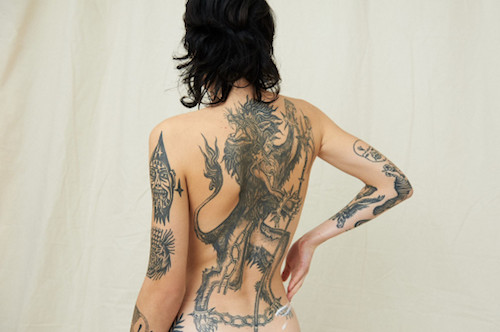 Back Tattoo
Back Tattoo
10. Finger Tattoo Designs: Balancing Aesthetics and Pain
How can design choices affect the pain level of finger tattoos? Design choices significantly affect the pain level of finger tattoos. Simpler, less intricate designs generally cause less pain because they require less time and less extensive needlework.
Consider these factors when choosing a design:
- Size: Smaller tattoos are typically less painful than larger ones. A small, minimalist design on the finger will be quicker to complete and cause less overall discomfort compared to a larger, more detailed piece.
- Complexity: Intricate designs with fine lines and shading require more time and precision, which can increase the level of pain. Opting for simpler designs with bold lines and minimal detail can reduce the duration and intensity of the pain.
- Placement: The location of the design on the finger also matters. Tattoos on the knuckles or inner finger tend to be more painful than those on the sides of the fingers due to the proximity to bone and nerve endings.
- Color vs. Black Ink: While not always a significant factor, some individuals find that colored ink requires more passes with the needle, potentially increasing discomfort. Black ink may be slightly less painful as it often requires fewer passes.
- Line Thickness: Thicker lines can be completed more quickly than fine lines, which require more precision and time. Choosing a design with bolder lines can help minimize the duration of the tattoo session and reduce pain.
Here are some design ideas that balance aesthetics and pain:
- Simple Symbols: A small heart, star, or geometric shape can be a meaningful and relatively painless option.
- Initials or Single Letters: These are quick to complete and can be a subtle way to express personal significance.
- Minimalist Bands: A simple band around the finger can be a stylish and less painful choice.
- Small Floral or Nature-Inspired Motifs: Opt for simple floral or leaf designs with minimal detail.
By carefully considering these design elements, you can choose a finger tattoo that aligns with your aesthetic preferences while minimizing pain. Always consult with your tattoo artist to discuss your options and get their professional advice on design and pain management.
Ready to explore more designs, find skilled artists, and learn about the best pain management techniques? Visit tattooat.com today and embark on a seamless and informed tattooing journey.
FAQ: Addressing Your Concerns About Finger Tattoo Pain
1. Are finger tattoos more painful than wrist tattoos?
Finger tattoos are generally more painful than wrist tattoos due to thinner skin, proximity to bone, and more nerve endings.
2. Can I use numbing cream on my finger before getting a tattoo?
Yes, you can use a numbing cream like Zensa Numbing Cream, which contains 5% lidocaine, to reduce pain during a finger tattoo. Apply 30-45 minutes before the session.
3. How long does the pain of a finger tattoo last?
The pain during the tattoo session lasts for the duration of the tattooing process, typically ranging from 30 minutes to a few hours, depending on the complexity of the design. Post-tattoo soreness can last for a few days.
4. What should I do to prepare for a finger tattoo to minimize pain?
Stay hydrated, eat a meal, avoid blood thinners, and apply a numbing cream before your appointment.
5. Are there any specific aftercare steps for finger tattoos to reduce pain?
Keep the area clean, moisturize regularly, and avoid exposing the tattoo to harsh chemicals or direct sunlight.
6. Do finger tattoos fade quickly?
Yes, finger tattoos are prone to fading due to frequent hand washing and exposure to the elements. Touch-ups may be necessary.
7. Is it better to get a finger tattoo on the side or on the knuckle to minimize pain?
Getting a finger tattoo on the side is generally less painful than on the knuckle due to slightly more flesh and fewer nerve endings.
8. Can the size of the finger tattoo affect the pain level?
Yes, smaller tattoos are typically less painful than larger ones as they require less time and less extensive needlework.
9. Is it possible to reapply numbing cream during a long finger tattoo session?
Consult with your tattoo artist before reapplying numbing cream, as it may affect the skin and ink absorption.
10. What kind of designs are best for finger tattoos in terms of pain?
Simpler, less intricate designs with bold lines and minimal detail are best for minimizing pain during finger tattoos.
